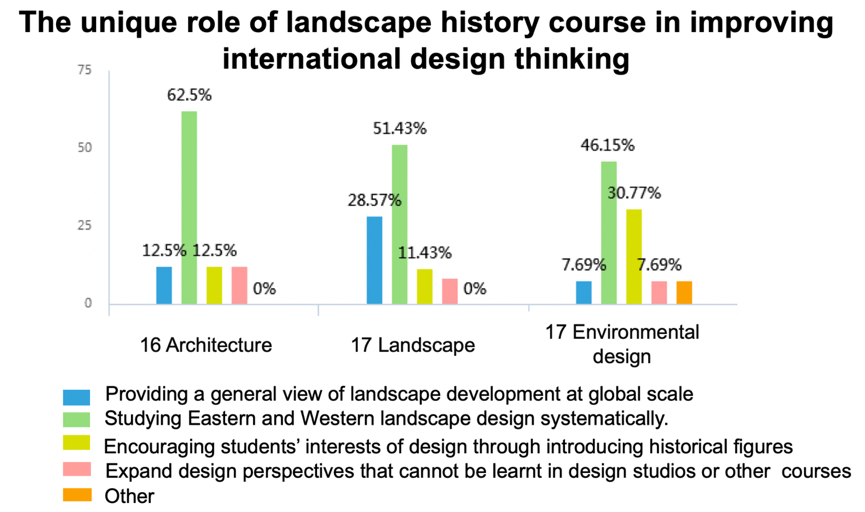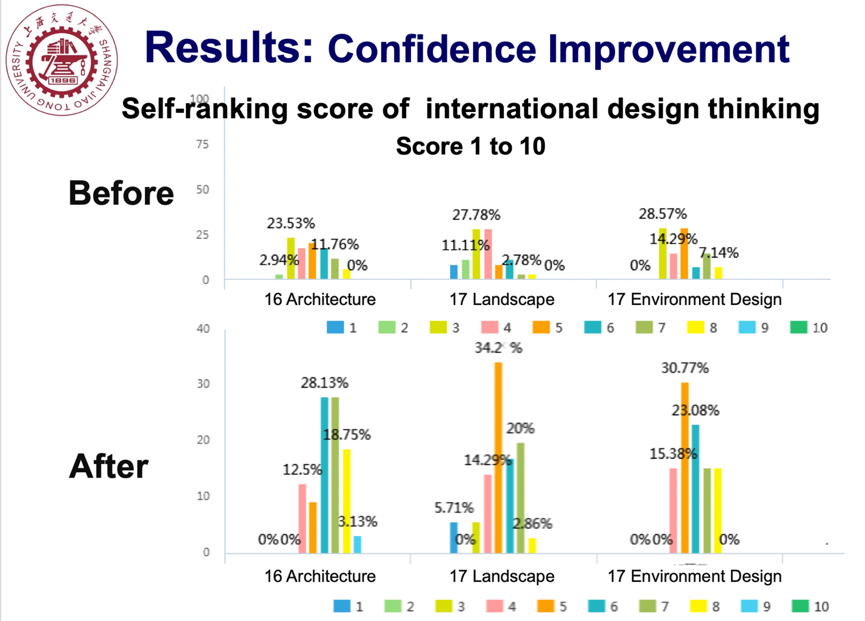Enhancing International Design Thinking through Landscape History Teaching and Learning – A Study at Shanghai Jiao Tong University
By Dr. Fei Mo
About the Author
Dr. Fei Mo, FHEA, PhD in Landscape Architecture, The University of Sheffield, UK. Dr. Mo is a lecturer in landscape architecture, School of Design, Shanghai Jiao Tong University (SJTU). She taught landscape history lectures, design studios and research in the Department of Landscape Architecture in the University of Sheffield from 2011 to 2015, and continued teaching landscape history, theory and design at SJTU since 2016. She has a long-term interest in teaching and learning research and practice.
Funding support: 2018 Shanghai Jiao Tong University Teaching and Learning Development Grant
Email: fei_mo@sjtu.edu.cn

1. Background
Landscape history is deemed to be a foundation to understand landscape developments, so most design schools which offer landscape architecture courses requesting students to learn landscape history at both undergraduate and postgraduate levels. At SJTU, the landscape history course (GA 207) is open to students from architecture, landscape architecture and environmental design backgrounds. It covers Chinese and international landscape history within one module, from 10000 B.C. to 2000 A.D.. This provides opportunities for students to compare different design philosophies and garden cultures. In 2019, sponsored by a teaching and learning grant from SJTU, a study on using multiple-level case studies to enhance students’ international design thinking was carried out. At the end of the course, students’ self-ranking score of their international design thinking level raised three points out of ten in average. This article is intended to share the story of the research and our reflections on it.
2. The Needs for an International Perspective
In recent years, international design thinking has become a significant factor that affects employability and postgraduate study in the domain of landscape architecture. Design competitions often call for proposals at the global scale, as this has been the main strategy to attract the most innovative and smart solutions. Without an international perspective, it is really hard to understand the global trend of design and produce outstanding proposals among worldwide competitors. To continue postgraduate study in world-leading universities, one should have basic comprehension of international design ideologies and have developed the awareness of being a global citizen. However, many of our students do not have opportunities to travel or study abroad before completing their four-year undergraduate programmes in China. Though SJTU has been a pioneer in promoting internationalisation of higher education since the 1970s, and has established global partnerships, there are blockers that stop students from getting international exposure, such as GPA, a fear to go abroad, English competence, financial status, and more. For one thing, undergraduate-level study is fundamental to shape one’s opinion of profession; for another, the lack of access to international environment directly limits the development of basic comprehension of the world outside of China. How to inspire students to look at a bigger picture and to enroll international design thinking training in teaching and learning is the main challenge to realise internaionalisation at the course level.
3. Enhancing International Design Thinking through Landscape History Teaching and Learning
The landscape history course is a compulsory module for year-two students from landscape architecture and environmental design, whilst an elective module for year-three students from architecture. In 2019, all students, 89 in total, were taught in one classroom, though their backgrounds and grades were different. Typical landscape history teaching is delivered by lectures, but this teaching method has many limitations. For example, students may only receive a lot of information, rather than develop their abilities and cognition. The disparity in learning status means that it is difficult to set out a one-fit-all teaching agenda, so an integrated approach was used to combine lectures with assessments to promote deep-learning and to respect the diversity of the learners. Our lectures narrated the historical lines of the developments, together with multiple-levels case studies that were designed to enhance students’ international design thinking by doing the assessments.
Multiple-Level Case Studies
There were three-level case studies in our course. The first level was case analysis in lectures: remarkable design cases were discussed and the international context of the developments were emphasised. The second level was student-led case studies after class. For year-two students who studied the course compulsorily, tree case studies of Chinese and international gardens were assigned in the beginning, middle and later stage of the course. This is to train them to analyse design cases critically and comprehensively, and the international context of the developments were emphasised. For year three architecture students, a comparative research study on Chinese and international landscape design philosophy and spatial design was the main assessment. As more advanced learners, architecture students were required to carry out a comparative study, and express original ideas on how the international trend of garden design influenced local development. The third level was case analysis in the final examination which assessed students’ learning outcomes.
International Thinking Development Criteria – Perspective Change
How to select a criterion to assess the development of international design thinking is a difficult part of research design. Not much literature directly discusses international design thinking development, but there are quite a few articles mentioned perspective change is a key to assess whether one’s mind has been shifted from local to international. In our study, we highlighted the international perspectives of landscape developments, and clarified links between historical study and international design thinking training in the first lecture. This is essential as students should be mindful to the connection, and their motivations and interests may be cultivated. According to our interviews with students in the class, not everyone was interested in studying history; quite a few students could not see how previous designs, such as those in ancient periods, could contribute much to resolving current environmental issues. But the enrollment of international design thinking training through design analysis brought a new aspect to study history, and in fact, cultivated their interests and passions.
Perspective changing is a training process while guidance is essential to facilitate the transformation. For instance, case study reports were assigned at the beginning, middle and the end of the course, while comments were given to shepherd improvements in choosing analytical aspects and critical thinking. The early stage case studies were more descriptive rather than analytical. But after several rounds of training, the last ones were much more improved in terms of contextualising the development in an international background, analysing design cases critically, expressing original opinions, and citing references correctly.
According to a survey at the end of the course, most students held positive opinions on enrolling international design thinking improvement in landscape history teaching and learning, and case studies were valued as a useful tool to develop their cognition. The survey of their self-ranking score of international design thinking raised from 3 to 6 out of ten in average. A t-test was carried out to check the credibility of the result, and it was proved to be reliable. Through comparative studies, students understood the similarity of local and international designs; this also reduced the fear of encountering with different cultures. Their knowledge of foreign gardens also improved significantly. This might be another reason that improved their confidence. In the beginning of the course, most students only knew less than five foreign gardens, but at the end, the number reached up to 40. Though it is difficult to identify every garden development in an international context, there are always possibilities to discuss whether there are cultural encounters that bring changes in garden culture in general.
4. Reflections International Perspective VS Local Identity Searching
Internationalisation in higher education cannot be achieved without course-level efforts. Cross-cultural studies, such as landscape history, provide opportunities for students to carry out comparative studies. Alison Hardie, an expert of the Chinese garden study, pointed out that in the 19th century, the establishment of foreign gardens in concessions in China inspired the Chinese to understand their unique garden culture. Without seeing designs fundamentally different from the local ones, one cannot distinguish local from international garden cultures easily. This reminds us of the significance of teaching Chinese and international landscape history at the same time. Many universities in China teach Chinese and international landscape history separately, or even only teach classical Chinese garden history. Students cannot understand the position of Chinese garden development without examining the international context.
Teacher’s Role in Constructive Learning
In recent years, student-centered learning has been a popular idea that affects our teaching design and evaluation significantly. However, according to our survey about students’ opinions on case studies, a large number of students stated that teacher-led case studies were essential. There are several possible reasons for this demand: lacking case study training in previous studies, students are not familiar with the method and wish to receive extra training; lacking confidence to carry out case studies from a historical perspective, as in design studios, they are not required to study historical cases in particular; lacking maturity for self-guide study though they should have developed essential independence. The survey reminds us of being realistic about student’s status and true needs. We should have a clear mind on why students should understand the international context and have an international perspective for them to achieve learning goals.
Cite this item
Mo, F. (2020, Aug). Enhancing International Design Thinking through Landscape History Teaching and Learning – A Study at Shanghai Jiao Tong University CoP – ITL Buzz, 10. Retrieved from https://www4.talic.hku.hk/cop-itl/whats-happening/enewsletters/issue-10/enhancing-international-design-thinking/



